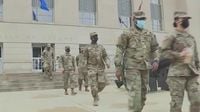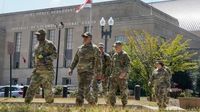On the streets of Washington, DC, the presence of the National Guard continues to spark debate, reflection, and, for some, a sense of unease. The federal takeover of the city’s police force may have ended, but the sight of uniformed soldiers remains a daily reality for residents in neighborhoods across the capital. Their deployment, extended through November 30, 2025, has become a flashpoint for questions about public safety, federal authority, and the future of policing in the nation’s capital.
According to FOX 5, the conversation has shifted from the initial shock of President Donald Trump’s decision to send in the National Guard to a more nuanced community discussion about how – or even if – these troops should be integrated into daily life. On September 23, 2025, Advisory Neighborhood Commissioner Tom Donohue convened a meeting in Ward 8, inviting residents to weigh in on what it would mean to welcome the Guard into their neighborhood. “We’re inviting the beautification part of this project into our communities, you know, and so, it’s important that we know that, you know, we’re not gonna see them with guns and we’re not gonna see them, you know, be there for show force,” Donohue told FOX 5. “But having their presence, I think it’s more community related.”
This approach signals a shift in tone from the tense days following President Trump’s controversial order. As reported by DW, the president justified the deployment by calling Washington a “lawless city,” even as a Department of Justice report showed violent crime in the city had actually dropped by 35% since 2023. The optics of 800 National Guard troops arriving – loading supplies, including ammunition and ready-to-eat meals, at their headquarters – only fueled the protests that had broken out in response to the federal takeover. Residents took to the streets, voicing their opposition and clashing with security forces in scenes reminiscent of earlier moments of civil unrest in the city’s history.
Yet, as the dust settled, the conversation evolved. The National Guard’s mission in DC, as explained by D.C. National Guard Director Marcus Hunt to FOX 5, is twofold: security and beautification. Beyond the expected role of keeping the peace, the Guard has been tasked with removing graffiti, picking up trash, and supporting neighborhood improvement projects. This, Hunt said, is about more than just appearances – it’s an attempt to build trust and foster a sense of safety that extends beyond the presence of armed personnel.
Not all neighborhoods have embraced the offer. Some have accepted the Guard’s assistance, while others have declined, wary of what a military presence might signal or change about the character of their communities. For those who have said yes, the results have been tangible. In the Fairlawn community, the Metropolitan Police Department reported a significant decrease in crime over the last 30 days: no homicides, a 67% drop in robberies, and an 80% decrease in car break-ins. Police attribute these improvements to a combination of their own efforts and the support of federal resources.
Still, the debate remains far from settled. The arrival of the National Guard, as documented by DW, was met with a steady stream of protests. Many residents viewed the move as an overreach, especially given the declining crime rates. Critics questioned the necessity of such a visible display of federal power, particularly in a city with a long history of fraught relations between local and national authorities. Mayor Muriel Bowser, according to DW, responded by emphasizing the city’s intention to “make sure we use” the extra forces in a way that benefits residents, hinting at a desire to find common ground between security and autonomy.
For others, the presence of the Guard is a reminder of the persistent tension between perceptions of safety and the realities on the ground. President Trump’s characterization of Washington as “lawless” struck many as out of step with the data, and for some, it revived old grievances about the ways in which the federal government intervenes in the life of the city. The debate over the National Guard’s role has thus become a proxy for larger questions about who gets to define security, how communities should be policed, and what it means to feel safe in one’s own neighborhood.
Commissioner Donohue, reflecting the concerns of many in Ward 8, stressed the importance of transparency and communication. He plans to bring the results of the recent community meeting to the full commission, ensuring that residents’ voices are heard as decisions are made about the Guard’s ongoing involvement. “It’s important that we know that, you know, we’re not gonna see them with guns and we’re not gonna see them, you know, be there for show force,” Donohue reiterated, underscoring the desire for a partnership rooted in service rather than intimidation.
Meanwhile, the soldiers themselves are preparing for a variety of tasks. As reported by DW, they were seen unloading supplies and readying themselves for a deployment that could last through the fall. Their orders, according to D.C. National Guard Director Hunt, extend beyond traditional security roles to include efforts aimed at improving the physical environment of the city. This dual mission – part guardian, part caretaker – is an attempt to redefine the relationship between the National Guard and the communities they serve.
Yet, the question lingers: will this strategy be enough to bridge the divide between those who see the Guard as protectors and those who view them as symbols of unwanted federal intervention? The answer, as always in Washington, is complicated. Some residents, buoyed by the recent drop in crime, are cautiously optimistic. Others remain skeptical, pointing to the city’s history and the need for lasting, community-driven solutions to the challenges it faces.
As the city moves forward, the presence of the National Guard will continue to shape the conversation about safety, authority, and the meaning of public service. Whether their stay ultimately brings about lasting change or simply marks another chapter in DC’s ongoing struggle for self-determination remains to be seen. For now, the city watches, waits, and debates – determined, as ever, to have a say in its own future.

